Overview
Developers often encounter significant challenges in their coding workflows, from testing to deployment. How can these hurdles be overcome? Kodezi offers a compelling solution by automating various tasks within the Continuous Integration (CI) pipeline using AI. This innovative tool enhances efficiency in software development through features that streamline workflows, such as automated testing, deployment, and debugging.
By leveraging tools like Kodezi, GitHub Actions, and CircleCI, developers can significantly improve productivity and code quality. Imagine reducing the time spent on repetitive tasks, allowing more focus on creative problem-solving. Furthermore, these tools not only automate processes but also provide insights that help in maintaining high standards of code integrity.
The benefits of using Kodezi are clear: improved efficiency leads to faster project delivery and higher quality code. In addition, by automating mundane tasks, developers can channel their energy into more complex and rewarding aspects of software development. Are you ready to transform your coding practices? Explore the tools available on the Kodezi platform and experience the difference for yourself.
Introduction
In the ever-evolving realm of software development, the challenges of delivering high-quality applications swiftly are more pronounced than ever. Developers often find themselves navigating the intricacies of coding, and this is where Kodezi steps in as a transformative solution. With its innovative features designed to tackle these coding hurdles, Kodezi stands out as a beacon of efficiency.
How can Kodezi enhance your productivity and elevate your code quality? By leveraging its capabilities, organizations can not only streamline their workflows but also significantly boost their overall productivity.
Explore the tools available on the Kodezi platform to discover how they can revolutionize your development processes.
Kodezi | Professional OpenAPI Specification Generator - AI Dev-Tool: Automate Code Maintenance and Debugging
Developers often face significant challenges in maintaining and debugging codebases. How can these issues be effectively addressed? Kodezi serves as a professional tool that automates these processes, ensuring consistent oversight of programming quality. By independently identifying problems and suggesting solutions, Kodezi guarantees that your project adheres to the latest security best practices and development standards.
This capability is particularly essential for AI automate CI pipeline, as it ensures that the program remains clean and compliant throughout the development lifecycle. Kodezi CLI not only identifies and resolves performance bottlenecks and security issues but also improves formatting in mere seconds. Furthermore, its integration with CI/CD tools allows teams to AI automate CI pipeline, facilitating seamless updates and documentation synchronization, making it a crucial resource for engineering teams striving for efficiency and reliability in their workflows.
Imagine the productivity gains when programmers of all levels utilize an AI-assisted programming tool like Kodezi. It optimizes, debugs, and corrects scripts while maintaining privacy protection. Are you ready to enhance your coding practices? Explore the tools available on the Kodezi platform and transform your development experience.
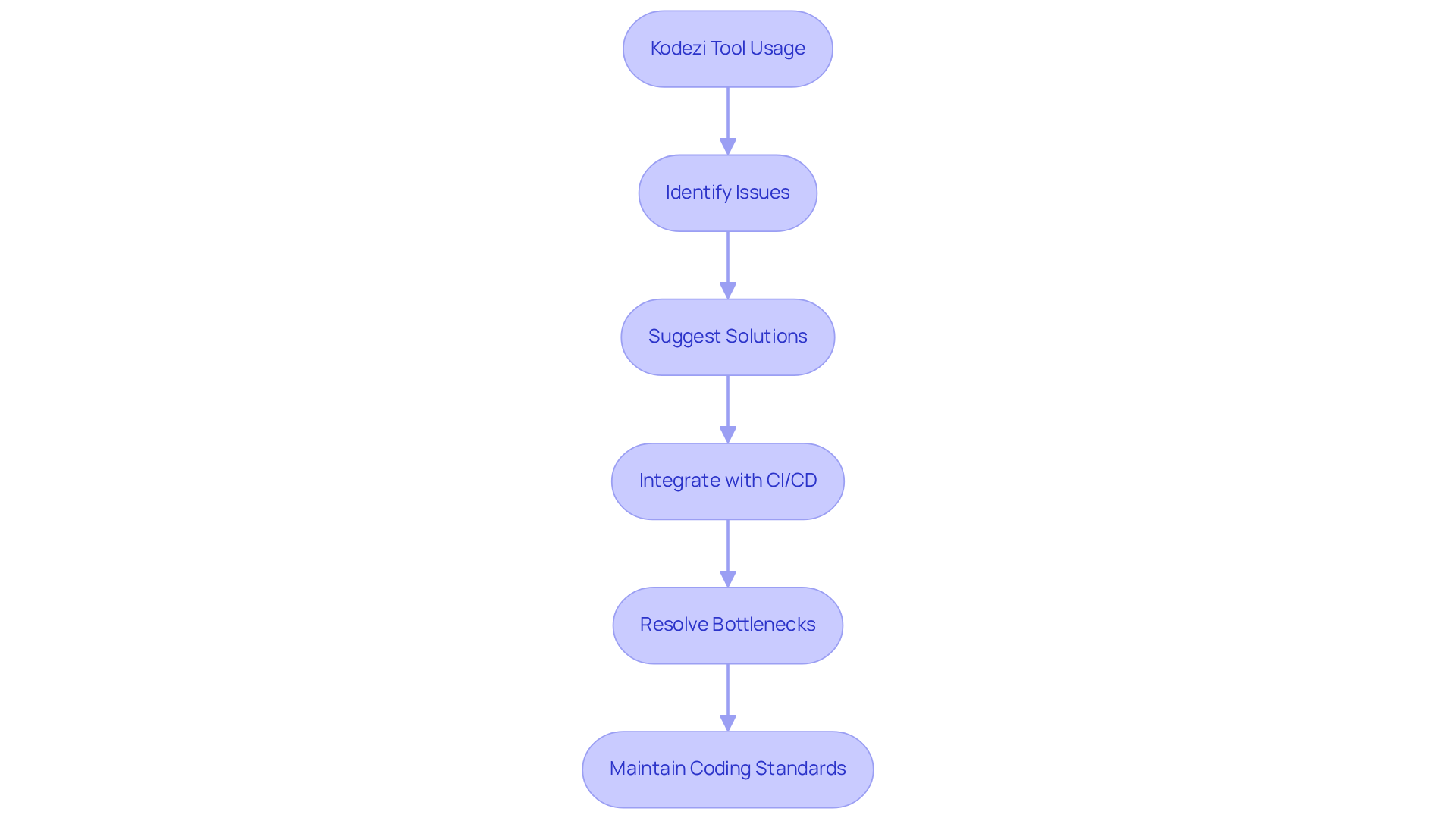
GitHub Actions: Streamline CI Workflows with Automated Actions
Developers often encounter significant challenges in managing their workflows, particularly when they attempt to ai automate ci pipeline. GitHub Actions provides a powerful solution to these issues, enabling automation directly within GitHub repositories. By utilizing YAML files to define workflows, teams can automatically trigger builds, execute tests, and deploy applications in response to code changes. This ai automate ci pipeline not only minimizes manual intervention but also accelerates the development process, ensuring consistency across deployments.
Furthermore, GitHub Actions boasts extensive integration capabilities, allowing teams to tailor their workflows to meet specific project requirements. For instance, teams that have implemented GitHub Actions reported a notable decrease in the time needed to finalize pull requests. This underscores the efficiency gains that the ai automate ci pipeline can bring.
As a result, developers can redirect their focus toward innovation rather than repetitive tasks. This shift ultimately enhances both productivity and code quality. Why not explore how GitHub Actions can transform your development workflow today?
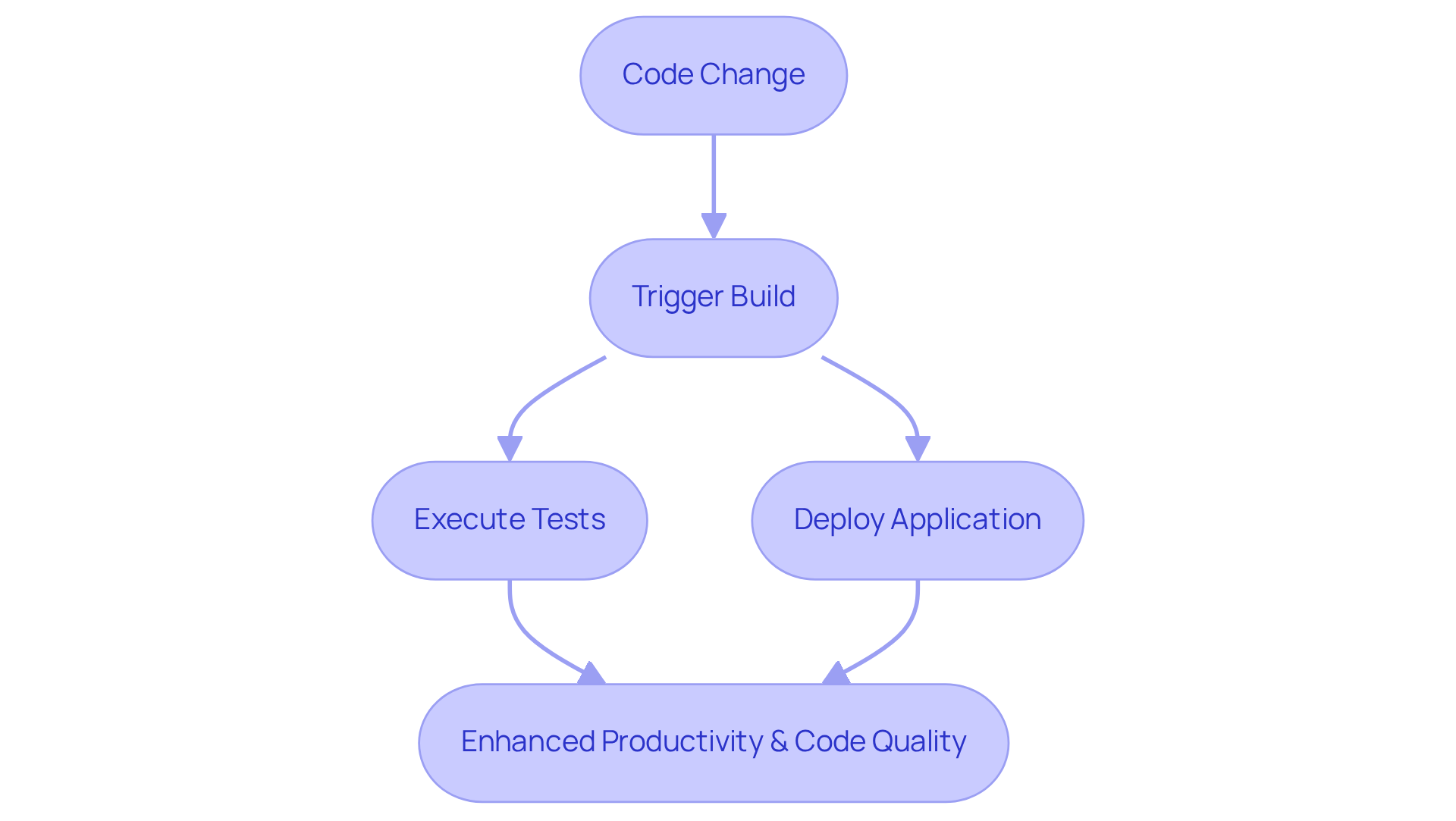
CircleCI: Accelerate Development with Continuous Integration Automation
In the fast-paced world of software development, teams often grapple with the challenges of efficiency and speed. CircleCI emerges as a powerful CI/CD platform that can ai automate ci pipeline, enabling groups to build, test, and deploy applications with remarkable speed. By executing tests in parallel, CircleCI significantly reduces build times, achieving an average workflow duration of just 2 minutes and 49 seconds. Furthermore, its seamless integration with various version control systems streamlines workflows, fostering efficient collaboration among team members.
Advanced features like caching and resource optimization further enhance operational efficiency. Teams can recover thousands of hours each year by debugging in minutes instead of days. The introduction of CircleCI releases allows developers to automate the release orchestration process directly from the CircleCI UI, providing end-to-end visibility of deployments and facilitating rollback commands when necessary.
High-performing teams utilizing CircleCI have reported shipping updates three times faster than their lower-performing counterparts. This underscores the platform's crucial role in driving productivity. As highlighted by industry leaders, the ai automate ci pipeline features of CircleCI have transformed continuous integration and delivery from a 'nice to have' into a 'must have' for contemporary software development. This reinforces its status as a strategic advantage in delivering high-quality software swiftly and dependably.

Jenkins: The Open-Source Automation Server for CI/CD Pipelines
Jenkins serves as an essential open-source automation server that enables developers to ai automate ci pipeline, allowing for efficient building, testing, and deployment of applications. Are you facing challenges in managing your software delivery processes? With more than 1,800 plugins available, Jenkins offers comprehensive customization and integration features, making it a flexible option to ai automate ci pipeline for continuous integration and continuous delivery workflows. Its support for ai automate ci pipeline enables teams to define and manage their build processes in a version-controlled manner, which enhances collaboration and traceability. Furthermore, this flexibility is complemented by a vibrant community of over 600 active contributors, ensuring continuous innovation and support.
Organizations leveraging Jenkins to ai automate their ci pipeline have reported significant improvements in their software delivery processes. For instance, the use of ai automate ci pipeline has contributed to a surge in monthly pipeline jobs from over 27 million to nearly 49 million, underscoring its effectiveness in automating complex workflows. In addition, to further improve code quality and streamline the continuous integration and delivery process, incorporating Kodezi's AI-driven automated code debugging can offer quick issue resolution, enhance performance, and ensure security compliance. This is achieved by enabling developers to access detailed explanations and insights into codebase problems.
While Jenkins remains a reliable option for implementing robust CI/CD practices, it is important to consider its limitations in cloud-native environments, which may affect the ability to ai automate ci pipeline effectively. Nonetheless, Jenkins continues to be a critical component in the toolkit of modern engineering teams, especially when paired with advanced tools like Kodezi. By exploring these tools, developers can significantly enhance their productivity and code quality.

Travis CI: Simplify Testing and Deployment with Cloud-Based Automation
Developers often face significant challenges in managing their code efficiently. Travis CI emerges as a robust cloud-based continuous integration service designed to automate the testing and deployment of changes, thereby significantly enhancing workflow efficiency. By integrating seamlessly with GitHub, it allows programmers to trigger builds automatically with every code commit, streamlining the creation process. Supporting a wide variety of programming languages, Travis CI employs a simple configuration file to outline build processes, making it approachable for teams of all sizes.
The impact of cloud-based CI services like Travis CI on deployment speed is substantial. Research indicates that restarted builds can slow down the merging of pull requests by a factor of three, increasing median merging time from 16 hours to 48 hours. By utilizing ai to automate the CI pipeline, Travis CI helps reduce such delays, ensuring that teams can maintain momentum in their development cycles.
Furthermore, Travis CI's cloud framework ensures scalability and dependability, positioning it as an ideal option for teams looking to streamline their continuous integration and delivery processes. As developers have noted, the integration of Travis CI with GitHub not only enhances collaboration but also fosters a more efficient testing environment. This synergy enables teams to concentrate on producing high-quality code while reducing manual intervention, ultimately enhancing productivity and innovation.
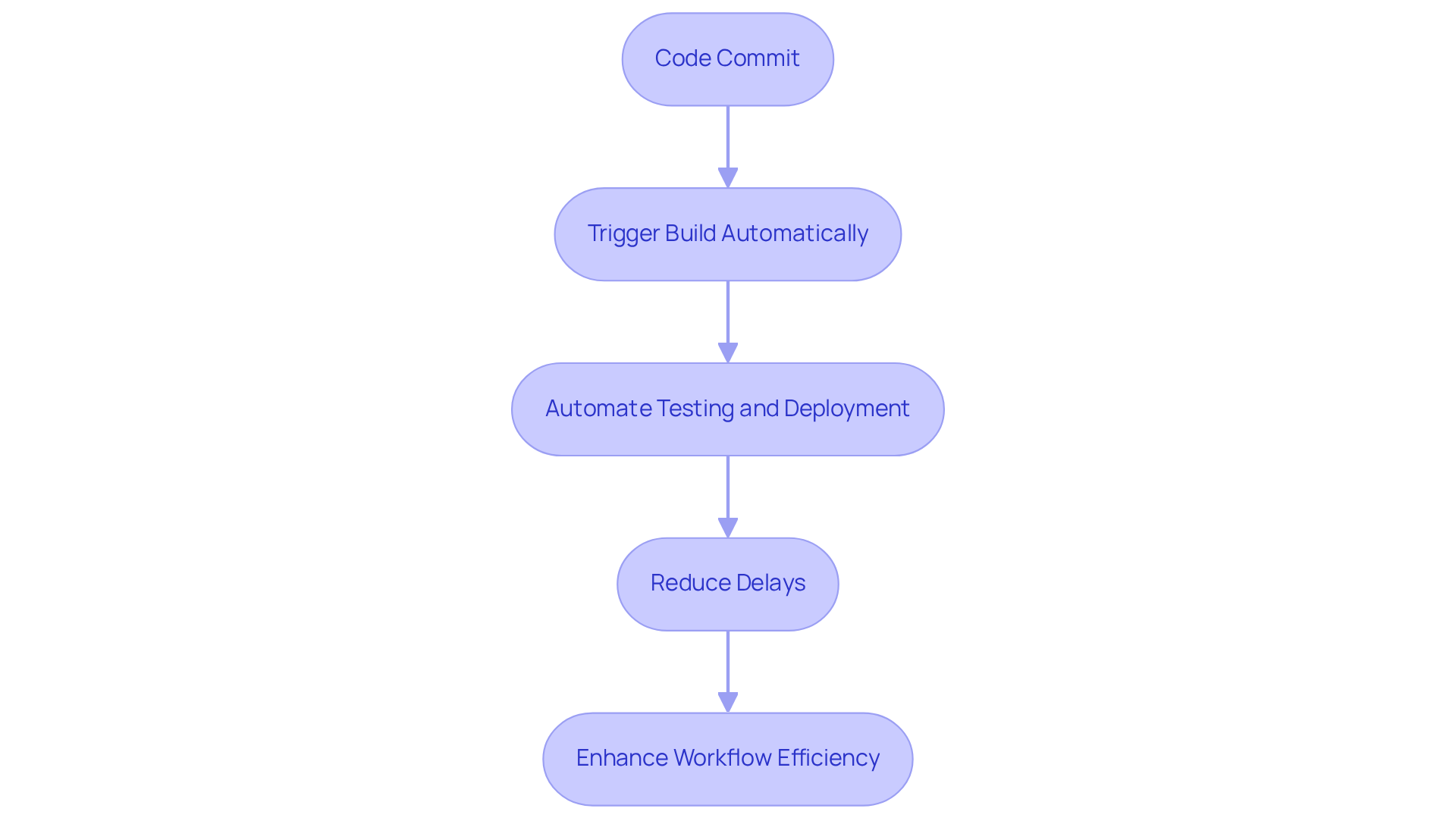
Azure DevOps: Comprehensive CI/CD Tools for Enhanced Automation
In today's fast-paced development environment, coding challenges can significantly hinder productivity. Azure DevOps offers a comprehensive suite of tools that enable teams to ai automate ci pipeline management throughout the entire software development lifecycle, including CI/CD capabilities. By leveraging Azure Pipelines, teams can ai automate ci pipeline to manage builds, tests, and deployments across various platforms. But how can developers tackle the complexities of debugging? This is where Kodezi comes in. With its AI-driven automated debugging, Kodezi enables teams to instantly detect and rectify issues within their codebase. It provides detailed explanations and insights into what went wrong and how to resolve it, transforming the debugging process into a more efficient task.
Furthermore, Kodezi addresses performance bottlenecks and security issues, ensuring compliance with the latest security best practices and coding standards. This not only enhances code quality but also boosts overall productivity. Imagine being able to focus more on innovation rather than getting bogged down by recurring issues. Azure DevOps seamlessly integrates with popular version control systems and offers features such as release management and artifact storage, making it a robust solution for modern development teams.
In addition, the strong analytical and reporting features of Azure DevOps, combined with Kodezi's functionalities, empower teams to track performance and refine their workflows. This positions Azure DevOps as an effective solution for organizations aiming to enhance their processes by utilizing ai automate ci pipeline. Are you ready to explore the tools available on the platform and elevate your development practices? Discover how Kodezi can transform your coding experience today.
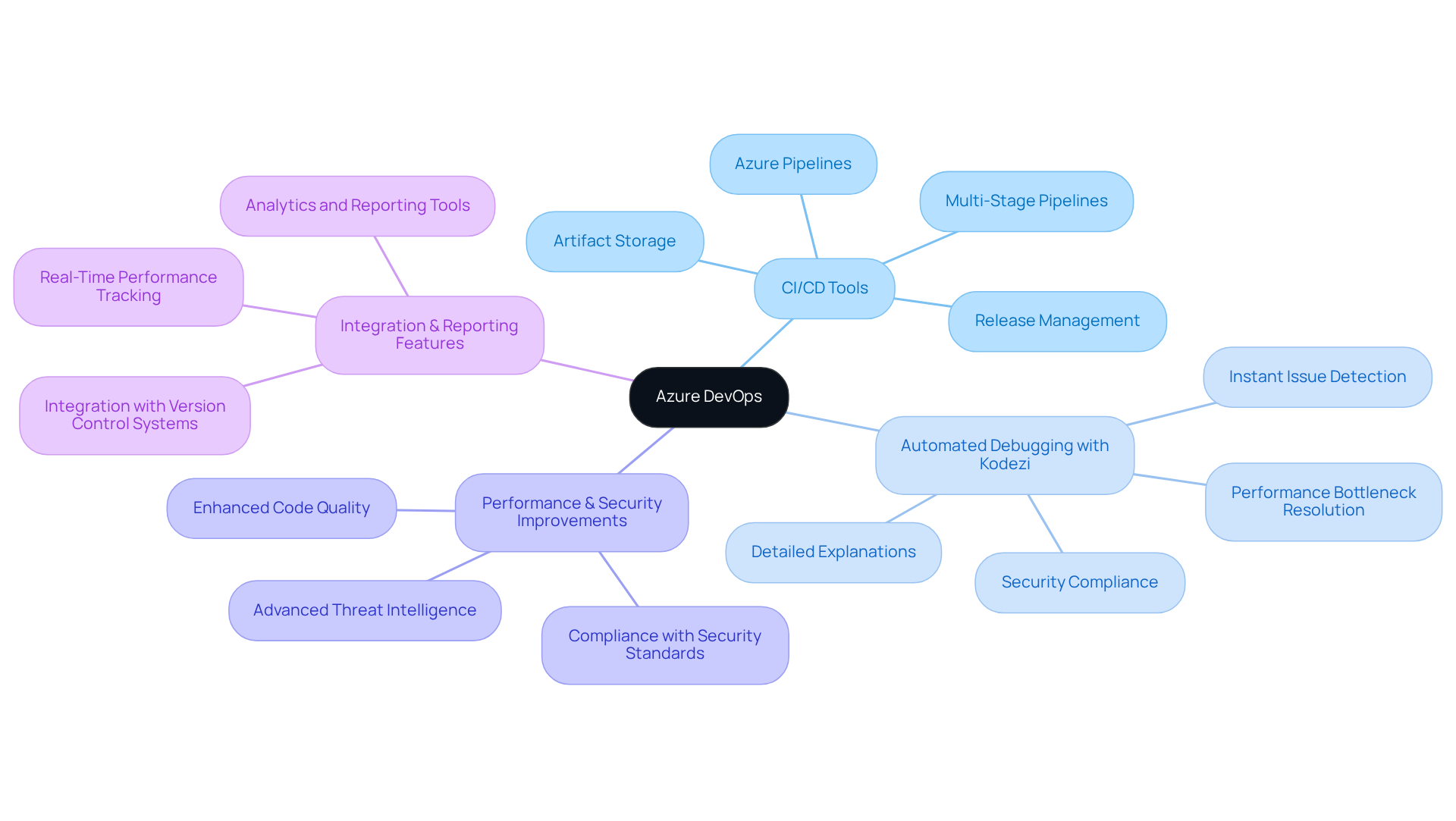
GitLab CI/CD: Integrated Automation for Streamlined Development
Developers often face significant challenges in the software creation lifecycle. GitLab provides a robust integrated solution that can AI automate the CI pipeline, streamlining the process from code commit to deployment. By enabling teams to define pipelines directly within their repositories, GitLab fosters collaboration and transparency among members. This integration supports parallel testing and deployment strategies, significantly accelerating release cycles.
So, how does Kodezi fit into this picture? Kodezi addresses common coding challenges by providing automated debugging features that allow teams to quickly identify and resolve codebase issues. With comprehensive explanations and insights into problems and their resolutions, Kodezi enhances productivity and ensures compliance with the latest security best practices and coding standards.
The benefits of using Kodezi are clear: teams can streamline their workflows, reduce manual errors, and ultimately deliver high-quality software more efficiently. Organizations that leverage AI automate CI pipeline with GitLab CI/CD report enhanced collaboration, with 86% of professionals recognizing the value of a DevOps culture for quicker software releases. Furthermore, by integrating tools such as Kodezi, teams can optimize performance and enhance code quality.
Are you ready to enhance your continuous integration and delivery processes? Explore Kodezi's features for a more efficient development experience and discover how it can transform your coding practices.

Bitbucket Pipelines: Automate CI/CD Within Your Bitbucket Repositories
In the ever-evolving landscape of software development, teams often encounter significant coding challenges that can hinder productivity and quality. Bitbucket Pipelines serves as a robust integrated CI/CD service, empowering teams to automate their build, test, and deployment processes seamlessly within Bitbucket. By utilizing a straightforward YAML configuration file, developers can define pipelines that trigger automated workflows in response to code changes, significantly enhancing efficiency.
Furthermore, the support for Docker containers allows teams to create isolated environments tailored for testing and deployment, ensuring consistency and reliability throughout various stages of development. This close integration with Bitbucket repositories not only fosters collaboration among team members but also simplifies the overall development process, making it easier to manage complex projects.
Organizations leveraging Bitbucket for build and deployment automation have reported improved cycle times and reduced bottlenecks. This showcases the tangible benefits of automation in their workflows, leading to enhanced productivity and code quality. Recent functionalities in Bitbucket's continuous integration and delivery further bolster these capabilities, providing developers with resources to optimize their pipelines and maintain high-quality software.
In addition, Kodezi's AI-powered automated debugging enables teams to promptly identify and resolve issues within the codebase, ensuring adherence to the latest security best practices and programming standards. This integration facilitates swift issue resolution, performance enhancement, and improved code quality, rendering it an essential resource for teams aiming to optimize their development processes.
Input from developers underscores the importance of Bitbucket's connection with development workflows. How does your team streamline its processes? By embracing these tools, teams can facilitate ongoing delivery and elevate their coding practices to new heights.
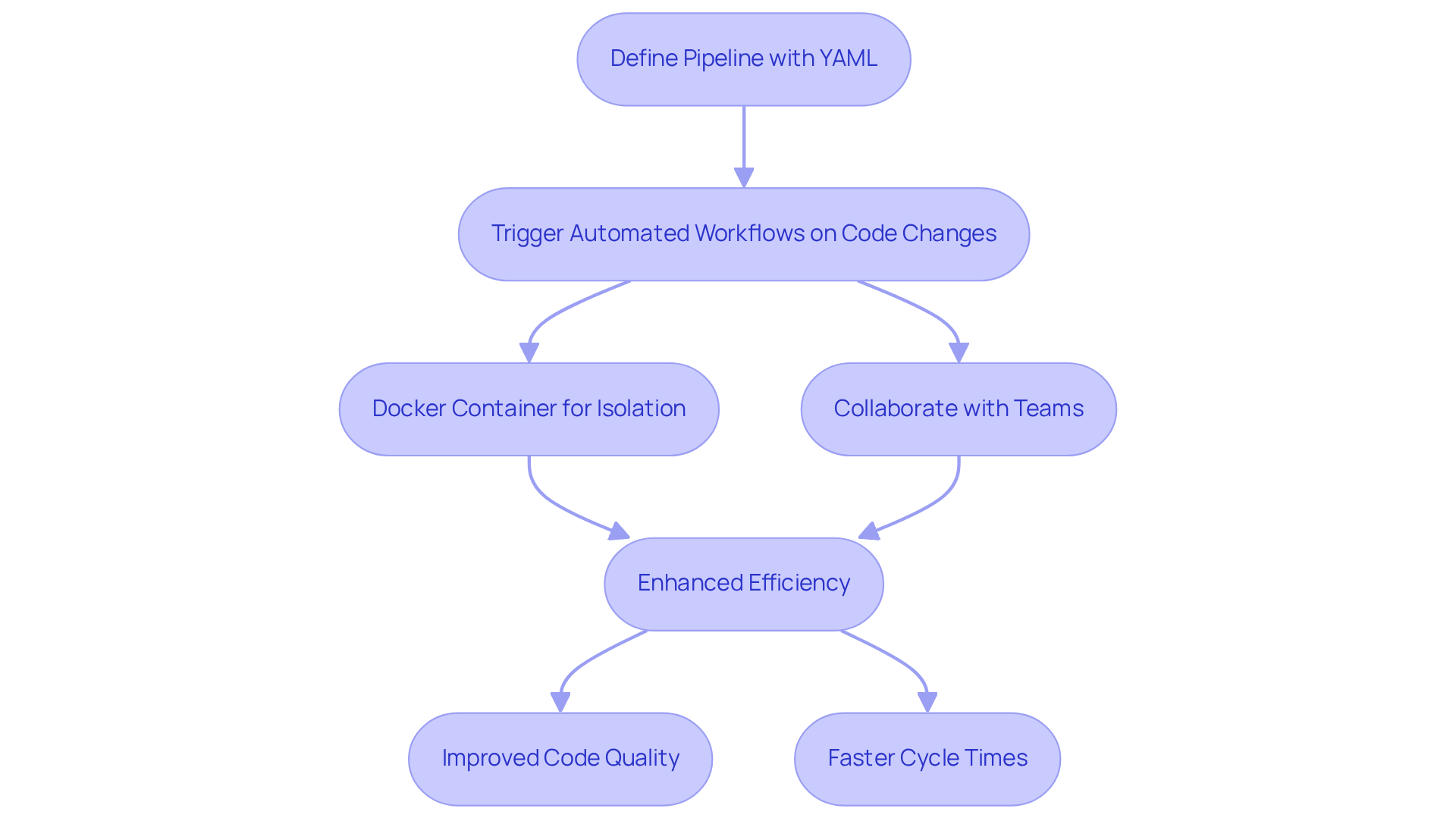
Semaphore: Fast and Efficient CI/CD Automation for Development Teams
In the rapidly evolving world of software development, developers often face significant challenges, particularly in managing time-consuming build processes. Semaphore, a cutting-edge CI/CD platform, addresses these issues by speeding up software creation through efficient automation. By enabling parallel execution of tests, Semaphore drastically reduces build times—some users have reported a remarkable decrease from 2 hours to just 8 minutes. This capability not only enhances feedback loops but also encourages teams to merge code more frequently, thereby minimizing deployment risks.
Furthermore, Semaphore integrates seamlessly with GitHub and Bitbucket, simplifying workflows and facilitating the adoption of continuous integration practices for software creators. Its user-friendly interface, combined with robust features such as automatic test parallelization, empowers teams to effectively enhance their CI/CD pipelines. Industry leaders have observed that using Semaphore has transformed the coding landscape, ensuring that codebases remain current and operational.
As the global continuous integration software market is projected to expand significantly, reaching USD 8.06 billion by 2033, Semaphore emerges as an essential tool for teams aiming to improve their development cycles while upholding high-quality standards. In addition, Kodezi, in collaboration with Semaphore, offers powerful functionalities like automated debugging. This feature allows teams to quickly detect and resolve issues within the codebase, ensuring adherence to the latest security best practices and programming standards.
The Kodezi CLI serves as a flexible tool for teams, enabling them to auto-heal codebases in seconds and substantially enhance programming productivity. By utilizing the AI automate CI pipeline from Kodezi for automated builds and testing, development teams can significantly improve code quality and optimize their release processes. This makes Kodezi a vital addition to any continuous integration and delivery pipeline. Are you ready to explore the tools available on the platform and elevate your coding practices?
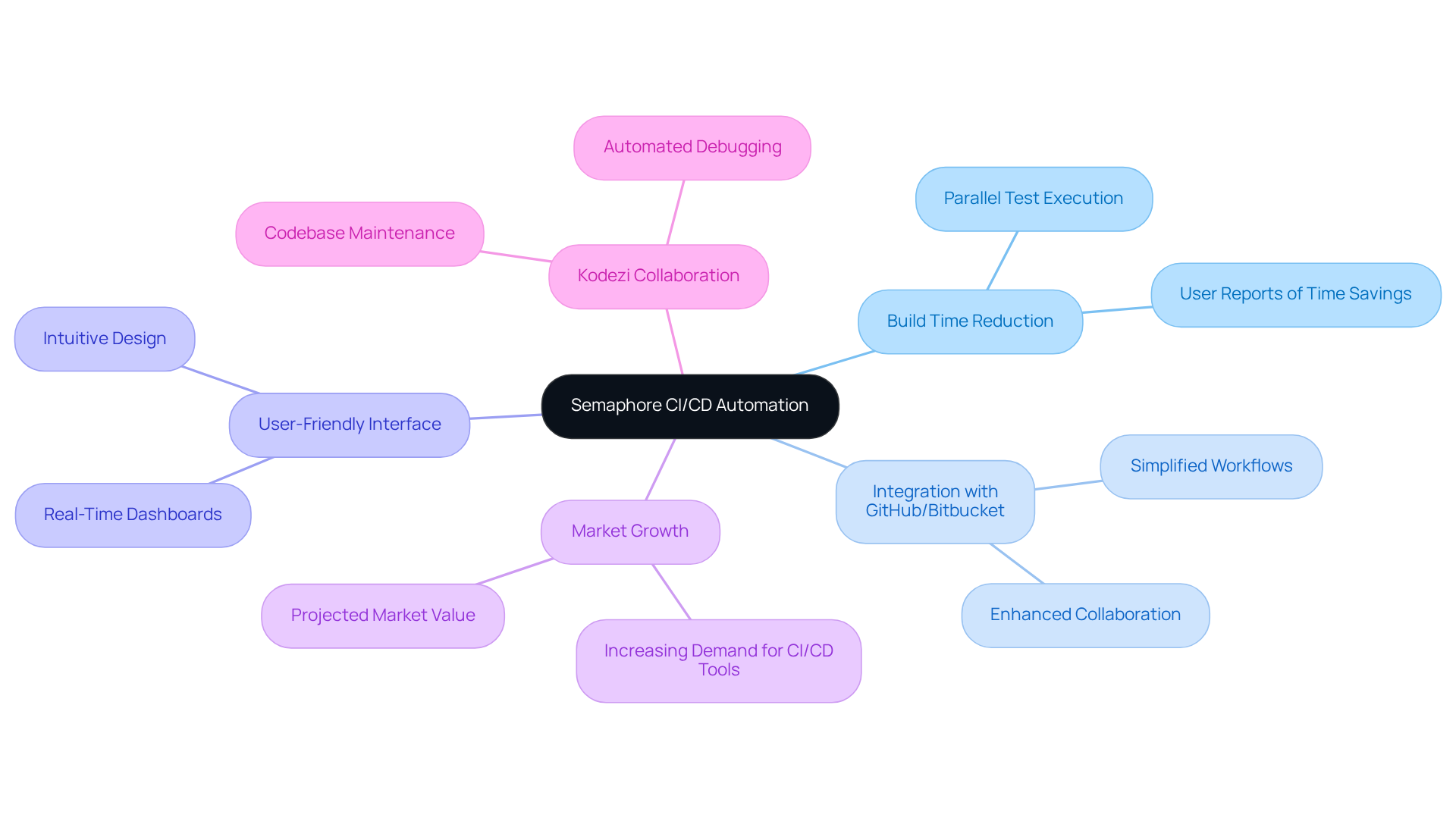
Harness: Continuous Verification for Automated CI/CD Success
In the realm of software development, coding challenges can significantly hinder progress. Harness stands out as a pivotal continuous delivery platform that addresses these challenges by prioritizing automated verification of deployments. By seamlessly integrating with a variety of monitoring and observability tools, it ensures that applications operate efficiently and adhere to performance standards post-deployment. Furthermore, the platform's sophisticated machine learning features play a crucial role in identifying anomalies and regressions, enabling teams to proactively tackle potential issues before they escalate.
This proactive approach not only enhances the reliability of software but also significantly improves deployment success rates. Organizations utilizing automated verification often report a marked increase in the quality of their software delivery processes. In addition, Harness effectively streamlines the CI/CD pipeline by leveraging AI to automate CI pipeline testing, deployment, and verification, making it an indispensable asset for teams striving for excellence in software delivery.
As software systems grow increasingly complex, the benefits of continuous verification become more evident. It fosters a culture of quality and efficiency within development teams. Are you ready to explore how Harness can transform your software delivery process and elevate your team's productivity?
Conclusion
AI automation in Continuous Integration (CI) pipelines addresses the coding challenges developers face, representing a transformative approach that can significantly enhance development efficiency and productivity. By leveraging advanced tools like Kodezi, GitHub Actions, CircleCI, and others, organizations can streamline their workflows, minimize manual errors, and maintain high-quality code throughout the software development lifecycle.
How does Kodezi specifically tackle these challenges? Kodezi excels in automating code maintenance and debugging, simplifying workflows for developers. GitHub Actions simplifies workflow management directly within repositories, while CircleCI accelerates build times and improves collaboration. Jenkins offers extensive customization through a rich plugin ecosystem. Furthermore, platforms like Travis CI and Azure DevOps provide cloud-based solutions that enhance deployment processes, and GitLab and Bitbucket Pipelines facilitate integrated automation.
As the demand for rapid software delivery continues to rise, embracing AI automation within CI pipelines becomes essential. Organizations are encouraged to explore these innovative tools and practices. By integrating AI-driven solutions, teams can focus on innovation, reduce bottlenecks, and ultimately deliver high-quality software more effectively. The benefits of using Kodezi not only improve development processes but also foster a culture of quality and efficiency.
Frequently Asked Questions
What is Kodezi and how does it assist developers?
Kodezi is a professional tool that automates code maintenance and debugging, helping developers maintain programming quality by independently identifying problems and suggesting solutions. It ensures adherence to security best practices and development standards.
How does Kodezi integrate with CI/CD tools?
Kodezi integrates with CI/CD tools to AI automate the CI pipeline, facilitating seamless updates and synchronization of documentation, which enhances efficiency and reliability in engineering workflows.
What productivity gains can be expected from using Kodezi?
Kodezi optimizes, debugs, and corrects scripts, allowing programmers of all levels to enhance their coding practices while maintaining privacy protection, leading to significant productivity improvements.
What challenges do developers face that GitHub Actions addresses?
GitHub Actions addresses challenges in managing workflows by allowing automation directly within GitHub repositories, enabling automatic builds, tests, and deployments in response to code changes.
How does GitHub Actions improve the development process?
By utilizing YAML files to define workflows, GitHub Actions minimizes manual intervention and accelerates the development process, ensuring consistency across deployments and allowing developers to focus on innovation.
What benefits do teams experience from using GitHub Actions?
Teams that implement GitHub Actions report a notable decrease in the time needed to finalize pull requests, leading to enhanced productivity and improved code quality.
What is CircleCI and how does it improve development efficiency?
CircleCI is a CI/CD platform that automates the CI pipeline, enabling teams to build, test, and deploy applications quickly by executing tests in parallel and streamlining workflows.
What advanced features does CircleCI offer?
CircleCI offers features like caching and resource optimization, which enhance operational efficiency and significantly reduce build times, allowing teams to debug issues much faster.
How does CircleCI impact the speed of software updates?
High-performing teams using CircleCI can ship updates three times faster than lower-performing teams, highlighting its role in driving productivity in software development.
Why is CircleCI considered a strategic advantage for software development?
The AI automate CI pipeline features of CircleCI transform continuous integration and delivery into essential components of modern software development, reinforcing its importance for delivering high-quality software quickly and reliably.




